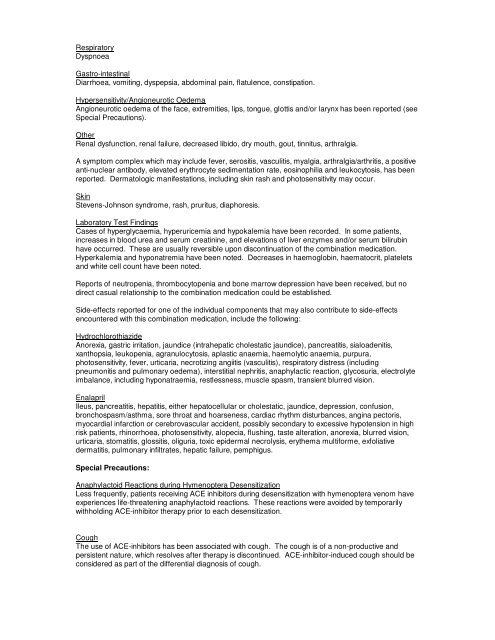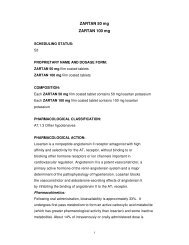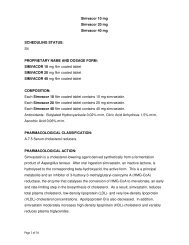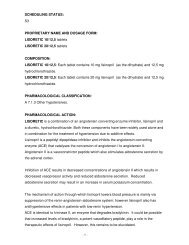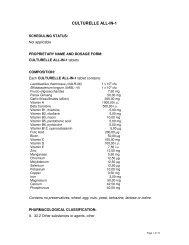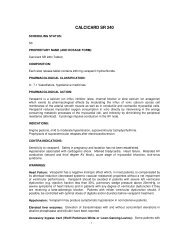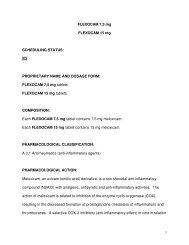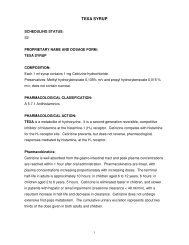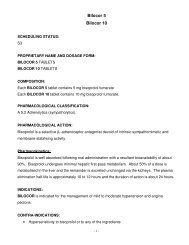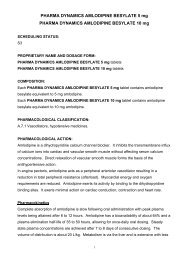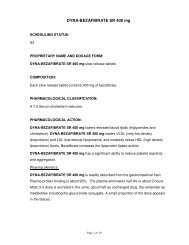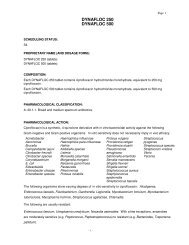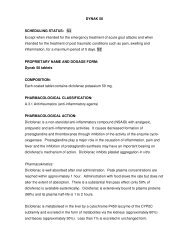ENAP-CO Tablets COMPOSITION - Pharma Dynamics
ENAP-CO Tablets COMPOSITION - Pharma Dynamics
ENAP-CO Tablets COMPOSITION - Pharma Dynamics
You also want an ePaper? Increase the reach of your titles
YUMPU automatically turns print PDFs into web optimized ePapers that Google loves.
Respiratory<br />
Dyspnoea<br />
Gastro-intestinal<br />
Diarrhoea, vomiting, dyspepsia, abdominal pain, flatulence, constipation.<br />
Hypersensitivity/Angioneurotic Oedema<br />
Angioneurotic oedema of the face, extremities, lips, tongue, glottis and/or larynx has been reported (see<br />
Special Precautions).<br />
Other<br />
Renal dysfunction, renal failure, decreased libido, dry mouth, gout, tinnitus, arthralgia.<br />
A symptom complex which may include fever, serositis, vasculitis, myalgia, arthralgia/arthritis, a positive<br />
anti-nuclear antibody, elevated erythrocyte sedimentation rate, eosinophilia and leukocytosis, has been<br />
reported. Dermatologic manifestations, including skin rash and photosensitivity may occur.<br />
Skin<br />
Stevens-Johnson syndrome, rash, pruritus, diaphoresis.<br />
Laboratory Test Findings<br />
Cases of hyperglycaemia, hyperuricemia and hypokalemia have been recorded. In some patients,<br />
increases in blood urea and serum creatinine, and elevations of liver enzymes and/or serum bilirubin<br />
have occurred. These are usually reversible upon discontinuation of the combination medication.<br />
Hyperkalemia and hyponatremia have been noted. Decreases in haemoglobin, haematocrit, platelets<br />
and white cell count have been noted.<br />
Reports of neutropenia, thrombocytopenia and bone marrow depression have been received, but no<br />
direct casual relationship to the combination medication could be established.<br />
Side-effects reported for one of the individual components that may also contribute to side-effects<br />
encountered with this combination medication, include the following:<br />
Hydrochlorothiazide<br />
Anorexia, gastric irritation, jaundice (intrahepatic cholestatic jaundice), pancreatitis, sialoadenitis,<br />
xanthopsia, leukopenia, agranulocytosis, aplastic anaemia, haemolytic anaemia, purpura,<br />
photosensitivity, fever, urticaria, necrotizing angiitis (vasculitis), respiratory distress (including<br />
pneumonitis and pulmonary oedema), interstitial nephritis, anaphylactic reaction, glycosuria, electrolyte<br />
imbalance, including hyponatraemia, restlessness, muscle spasm, transient blurred vision.<br />
Enalapril<br />
Ileus, pancreatitis, hepatitis, either hepatocellular or cholestatic, jaundice, depression, confusion,<br />
bronchospasm/asthma, sore throat and hoarseness, cardiac rhythm disturbances, angina pectoris,<br />
myocardial infarction or cerebrovascular accident, possibly secondary to excessive hypotension in high<br />
risk patients, rhinorrhoea, photosensitivity, alopecia, flushing, taste alteration, anorexia, blurred vision,<br />
urticaria, stomatitis, glossitis, oliguria, toxic epidermal necrolysis, erythema multiforme, exfoliative<br />
dermatitis, pulmonary infiltrates, hepatic failure, pemphigus.<br />
Special Precautions:<br />
Anaphylactoid Reactions during Hymenoptera Desensitization<br />
Less frequently, patients receiving ACE inhibitors during desensitization with hymenoptera venom have<br />
experiences life-threatening anaphylactoid reactions. These reactions were avoided by temporarily<br />
withholding ACE-inhibitor therapy prior to each desensitization.<br />
Cough<br />
The use of ACE-inhibitors has been associated with cough. The cough is of a non-productive and<br />
persistent nature, which resolves after therapy is discontinued. ACE-inhibitor-induced cough should be<br />
considered as part of the differential diagnosis of cough.


